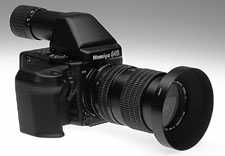
 Any photographer tackling weddings today will know that a good 35mm compact
camera can run rings round the most expensive Hassel-blad in terms of
manoeuvrability, speed of action, and capturing quick shots. No-one
seriously suggests that a professional should arrive with a Contax TVS or
a Minolta 135EX in his or her pocket, but everyong knows that a guest is
going to have one.
Any photographer tackling weddings today will know that a good 35mm compact
camera can run rings round the most expensive Hassel-blad in terms of
manoeuvrability, speed of action, and capturing quick shots. No-one
seriously suggests that a professional should arrive with a Contax TVS or
a Minolta 135EX in his or her pocket, but everyong knows that a guest is
going to have one.
While you work with a tripod, moving the entire assembly backwards and forwards to optimise the composition as your groups change size, an affluent and visually literate family member can be snapping away with an optically fine 35mm instrument zooming from 28 to 80mm or 35 to 135mm without any of the encumbrance of an SLR kit, which few wedding guests will now turn up with. At least that has changed for the better since the 1970s.
The British weather works wonders by wiping the grins off the faces of those who try to use models like the TVS (f5.6 maximum aperture at standard focal length) or 135EX (rather minimal f9.5 at 135mm). Either that, or they're forced to load up with 400-speed film, and despite the available quality of Fuji Super G they�ve probably bought more traditional own-branded stuff from a chainstore, and even on a 6 x 4 print the grain shows.
This still leaves the rest, who are blessed with sunny days, buy good quality 200 speed film, know the limitations of the camera and end up with some cracking stuff while you are changing compositions.
The answer is to fight back with the same facility - a zoom lens, auto exposure and a motorized camera. While you can buy zooms for all rollfilm SLRs (even for the Exakta 66 and its Pentacon bayonet Russian equivalents) there's one particular zoom which stands out for wedding use � the Mamiya 645�s 55-110mm. This lens is the equivalent of a 35-70mm on 35mm, covering angles from 65 to 35 degrees, and has a fixed f4.5 maximum aperture. It is reasonably small and light at 104mm long and 800g, and takes 67mm filters. It is a twin-ring design with a very smooth and positive zooming action, and is only let down by a slightly restricted minimum focusing distance of 5 feet, and no half-stop aperture settings.

At weddings, the focusing distance is not really a problem but the lack of half-stops makes an already tall order - fill-in flash with an SLR limited to 1/60th synch speed - just a touch harder to achieve. You need a fully controllable flashgun.
The main benefit of the 55-110mm is that you can set up the camera in one position and rapidly frame a succession of groups perfectly. This removes those pauses during which amateurs can pinch partial group shots, and speeds up the whole process. The lens has similar benefits for all types of social photography, PR work, executive portraiture and much industrial and commercial location shooting.


How 55 and 110mm compare on an actual shot - more difference than you would imagine
You can also switch from full length bridal and couple to portrait compositions very rapidly. The working distances provided by the 55-110mm range are better by far than tackling the same shots on an 80mm and 150mm, and the only reason to fit a longer lens might be for a solo portrait with a carefully selected background area.
While there is a trace of linear distortion at the long end, the optical quality of the 55-110mm is impossible to distingish from the prime lenses on a 12 x 16 print. You can just tell the difference on a 20 x 24 at the edges. Flare is well-controlled, just as well given the relatively useless wide-angle lens hood, and curvature of field is not present at closer focus distances, perhaps because those distances are just not very close to start with.
The 55-110mm is an affordable solution, unlike the leaf-shutter zoom lenses from Zeiss and Schneider for Hasselblad, Rollei and Bronica. Combined with the Mamiya Pro 645 and winder, plus AE prism, you have the equivalent in terms of speed and ease of use to a compact 35mm. Attach an auto flashgun and you can work hand-held for candids and casual shots without losing your rollfilm quality edge.
If you undertake weddings or any similar work, and use the Mamiya 645 system, try to lay hands on one of these rarely-seen midrange zooms, and see if you agree with me. I have to admit I have never seen one in use, and I've looked into hundreds of camera outfits. I have to presume that dealers don�t stock this lens widely, and it is certainly not advertised in its own right. I have to rate it as the most useful lens any social photographer could own.
Mamiya does understand the limitations of focal plane shutters in wedding and portrait work, and it is true that they lead the field in offering a complete leaf-shutter lens kit - 55mm f2.8, 80mm f2.8 and special 150mm f3.8 - for the 645. In theory, this is the outfit which is aimed at the wedding operator.
If they were to make a leaf shutter version of 55-110mm they would probably have the best 15-on-120 social photography option on the market.